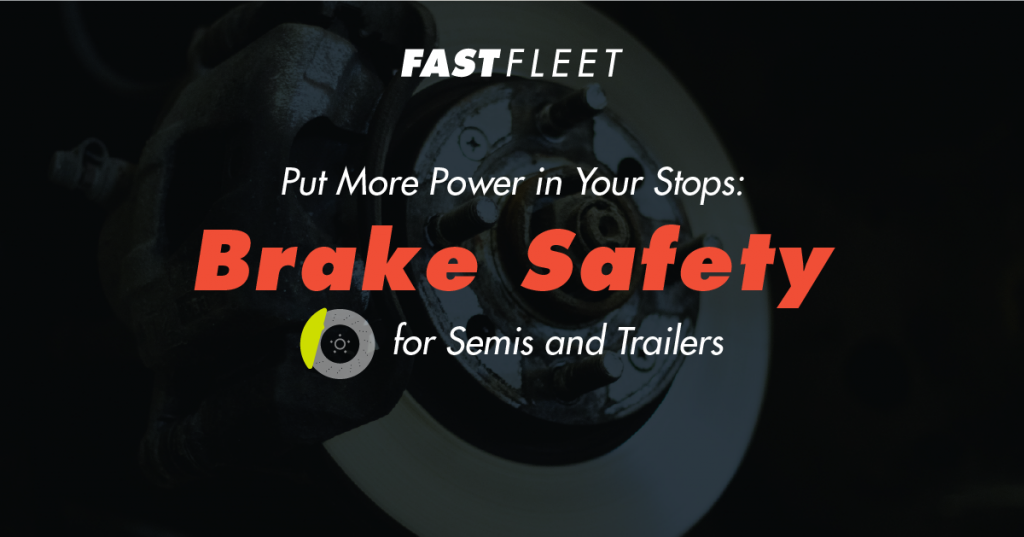Every year, thousands of truck crashes occur on our nation’s highways and interstates. Some of those are unavoidable. Others are caused by external factors, such as the other driver. However, a significant percentage of those accidents (27% according to a 2017 study by the FMCSA on the causes of trucking accidents involving injuries) are due to faulty brakes.
In other words, more than 25% of the trucks traveling America’s roadways have some sort of brake problem that is likely to lead to an accident – and not just any accident, but one involving injuries.
The good news is that this trend is reversible. Brake-related accidents don’t have to happen – they’re caused by a failure to take care of a truck’s braking system properly and a lack of information about brake safety.
It Starts with Safe Driving
Brake safety has implications across all areas of driving and maintenance, but it begins with safe driving. Owners should install telematics systems to keep an eye on driving habits that can affect brake life (and other factors, like tire life), but drivers should also remember important tips.
Be Defensive: Perhaps the most important driving tip is this – be a defensive driver, not an offensive driver. Offensive drivers put more wear on their brakes and also cause more strain so that systems that are already close to failure can be pushed beyond the tipping point. Defensive driving will help reduce the need to slam on your brakes, which limits brake wear and tear.
Drive Slow: Yes, time is money, but speed kills. Even if your brakes are in good condition, speeding can lead to accidents that injure or kill others. Couple high rates of speed with brakes that are only so-so or that need repairs or replacements and you have a recipe for disaster.
Drive for Conditions: Drivers are under pressure to drive for delivery times, but those times don’t take into account the conditions you’ll encounter. They’re based on best-case scenarios,
which always include dry pavement and good visibility. Instead, drivers should drive for conditions such as rain, fog, wind, heavy traffic, and more.
Know the Warning Signs
Truck brake systems are complex and it’s hard for a driver to check every single component on their own. Knowing a few signs to watch for and what each can indicate will help improve your brake safety.
1. Pull to one side. If you press the brakes and the truck feels as though it’s pulling in one direction, chances are there’s a balance problem. However, determining that there’s a balance problem and locating that problem can be incredibly complex.
It could be a problem with glazing on a drum’s inner surface. It might be a kink in a line or a mismatch in brake lining. It could be a problem in the air system, such as a size mismatch between the brake chamber valves, or a valve being blocked.
To help you hone in on the issue, try to note the circumstances under which you notice the behavior. Is it primarily when the truck is fully loaded? Lightly loaded? Empty? Is it only on heavy application of the brakes? Is it speed-related? Do you notice it primarily on wet pavement? Do you only notice it with a specific trailer?
2. Stability problems. Unlike passenger car systems, semi brakes are designed to apply and release sequentially. That order begins with the rear brakes and then moves forward. However, problems with brake timing can create serious safety issues. They can be noticed, though.
One sign is a sense of instability. For instance, if the tractor brakes activate prematurely, the trailer can bump into the truck. Or, if trailer brakes do not release correctly and hang on too long, it could lead to loss of control during a skid.
As with the previous symptom, instability can be related to a host of underlying problems. For instance, problems with the valves, such as a blockage, could mean that air doesn’t evacuate the chamber fast enough, leading to brakes sticking.
3. A lack of lubrication can also be a problem, as can valves opening at the wrong pressure due to age or other factors. Drivers should watch for other things beyond the trailer bumping or the sense of additional drag from the trailer. For instance, if you apply the brake and feel a pushing sensation, it could be a sign that the tractor brakes are applying first and the trailer brakes are slow.
Reports
The solution to the things we’ve discussed above is as simple as it is overlooked: the driver must write up a report. Every single thing that felt out of the usual should be noted, whether
that’s a sensation of pushing when applying the brake, strange noises, a feeling of drag from the trailer, or something else.
Be as specific and detailed as possible when making your report for the mechanics, and whatever you do, don’t get behind the wheel of a truck if you feel that the brakes are unsafe. Remember that it’s usually the driver who takes the brunt of the blame in an accident.
Inspections: The Most Critical Step
Perhaps the single most important step in maintaining brake safety and reliability is the most overlooked – these systems must be inspected regularly. The fact that truck brake systems are quite complex does not help matters. Thankfully, there are simple ways to get around these issues.
Drivers should walk around the vehicle before getting on the road. Even just 10 or 15 minutes could mean the difference between a safe trip and being stuck on the side of the road waiting on repairs, or worse, being involved in an accident that could have been avoided. It’s also important for drivers to know some of the signs to look for that might indicate braking problems – it’s not as simple a checking the pad thickness remaining as you would with a passenger car.
Brake adjustment: Perhaps the most common sign of brake system problems is improper adjustment. This should be a proverbial no-brainer for drivers. Brake adjustment (or lack thereof) is one of the most basic signs of trouble and any self-respecting driver should check the adjusters for slack before getting on the road. However, if the truck is equipped with self-adjusting brakes and there is slack in the adjusters, take this as a warning sign.
Tire pressure: Look for signs of abnormal tire wear. Using the brakes will accelerate wear, particularly harsh braking. Keep tires at their proper inflation rate to help eliminate other potential causes of abnormal wear.
Hoses and tubing: Drivers (and those performing maintenance) should also inspect the brake hoses and tubing. Chafed brake hoses are safety violations, but they also pose risks – a chafed hose can blow while on the road, leading to a loss of braking performance and potentially causing an accident. Note that if thermoplastic nylon tubing often uses different colored plies. If the second ply is visible, it’s a sign that the hose needs to be replaced (it’s also an out-of-service violation).
In addition to signs of chafing, make sure that there are no visible leaks, that all hoses are properly connected, and that they have a good amount of flexibility remaining. Any signs of bulging or swelling should be reported immediately and the hose should be replaced right away. Any air leakage from the system should be noticed, and the driver should ensure that all hose and tube connections use correct clamps. Finally, drivers should be familiar with indications that might point to an airflow restriction.
Damaged/missing components: Drivers should inspect for any components that might be damaged or missing. Slack adjusters are one example (remember not to try to manually adjust self-adjusting brakes). Other examples include missing clevis pins, broken brake chamber brackets, damaged camshafts, and more.
Pads and linings: Check for any cracks or signs of contamination with pads and linings. Also, note that S-cam drum brake pads should be measured at the center and must be 6.4 mm at a minimum. For trucks with air disc brakes, the pad must measure at least 3.2 mm.
Brake fluid: While it plays a slightly different role in semis than it does on passenger cars, brake fluid is another critical thing to check. Make sure that the reservoir is not leaking, and check the fluid level, too. However, drivers need to remember that the level will drop as pad thickness declines. Topping the reservoir off in this instance could lead to an overflow when the brakes are replaced.
More important than level (as long as there are no signs of leaks) is the condition of the fluid. Like oil, brake fluid will degrade over time and through use. Semi braking creates an immense amount of heat that can scorch brake fluid and accelerate the degradation. With enough deterioration, you’ll experience “brake fade” which is a loss of stopping power. In most cases, this means that you’ll need a brake fluid flush to replace all the old, burnt fluid in the system.
Know How to Measure Pushrod Stroke
Drivers should also measure the pushrod stroke for non-disc brakes. To do this, make sure that the pushrod is in the normal released position and that the engine is off. The air pressure should be between 90 and 100 psi, and the parking brake should be off. Then, follow these steps:
- Measure the brake chamber and determine its type (long or short stroke).
- Mark on the pushrod where it exits the brake chamber.
- Apply the brakes fully (you will need another person, or a brake application device for this).
- As the brakes are applied, listen for leaks (service side).
- Measure the distance from the mark you made to the face of the brake chamber.
- Double-check that the measurement is within legal limits.
Not Just the Driver
It’s not enough for drivers to inspect their truck and trailer, though. Yes, an experienced driver should know the signs to watch for that the truck or trailer’s brake system needs work. However, putting all that pressure on one individual is a mistake.
For both drivers and mechanics, the CVSA has a handy, printable checklist to help ensure an accurate brake inspection takes place every time.
Be Proactive
Every year, there’s a push for awareness ahead of Brake Safety Week. However, this critical safety system shouldn’t be an afterthought. Be proactive about maintenance and repairs. Be religious about inspecting and reporting. Create a reporting and inspection strategy, know the signs and symptoms to watch for, and master safe driving and braking to extend the life of your brakes and avoid the need for roadside assistance or the possibility of being involved in an accident.
Fast Fleet isn’t only here to help in an emergency situation. We’re here to help ensure you maintain compliance with applicable DOT regulations. Our certified technicians have extensive experience in the heavy truck repair industry; they know what to look for during your vehicle’s inspection.
Source:
https://www.interstatemc.com/2019/08/30/preparing-your-trucks-for-brake-safety-week/ https://www.fleetowner.com/safety/article/21703009/after-brake-safety-week-keeping-those-truck-brakes-safe https://cvsa.org/wp-content/uploads/Brake-Inspection-Check-List.pdf https://www.ta-petro.com/blog/post/cvsa-brake-safety-week-q-and-a https://www.finditparts.com/blog/preparing-for-brake-safety-week-a-few-tips-for-the-american-truckers https://www.fmcsa.dot.gov/safety/research-and-analysis/large-truck-crash-causation-study-analysis-brief https://www.fmcsa.dot.gov/safety/data-and-statistics/large-truck-and-bus-crash-facts https://www.truckinginfo.com/152844/what-drivers-should-know-about-brake-problems
















